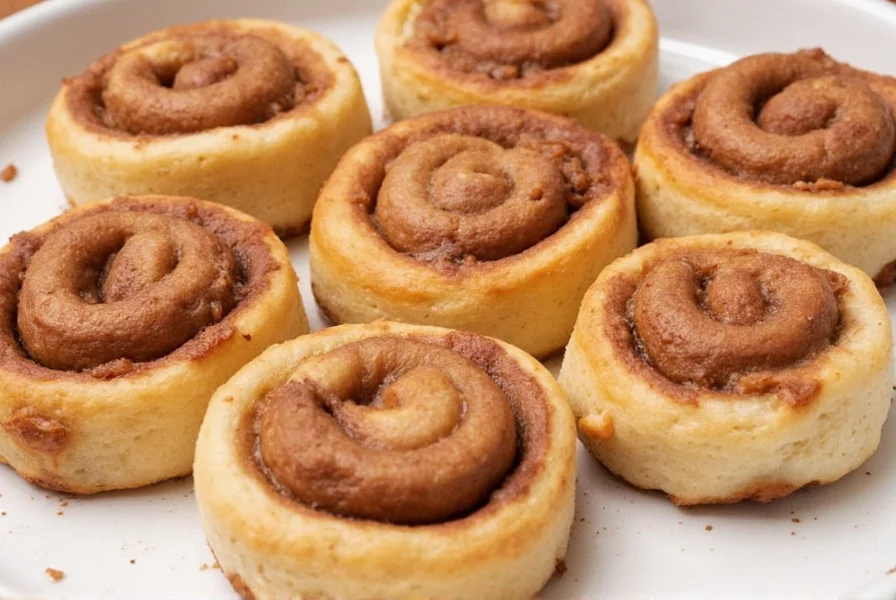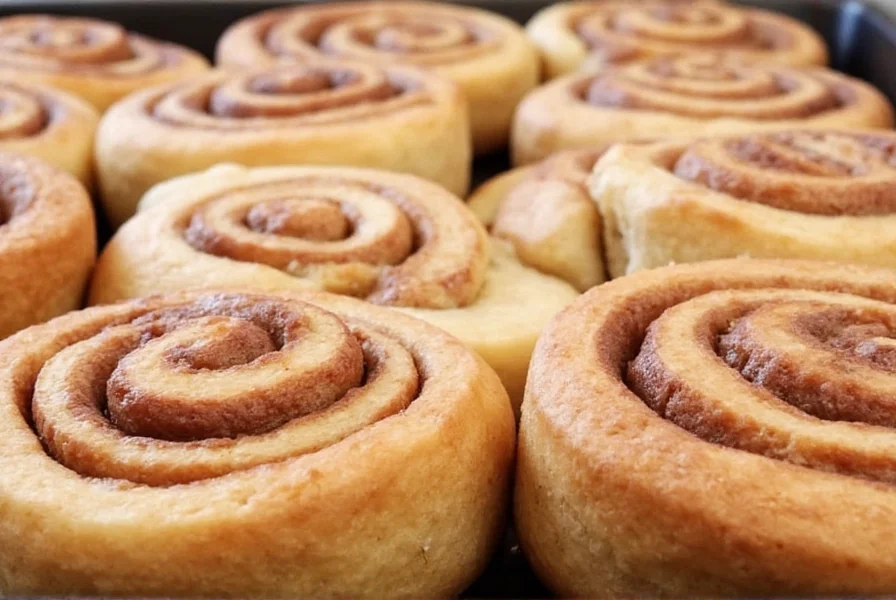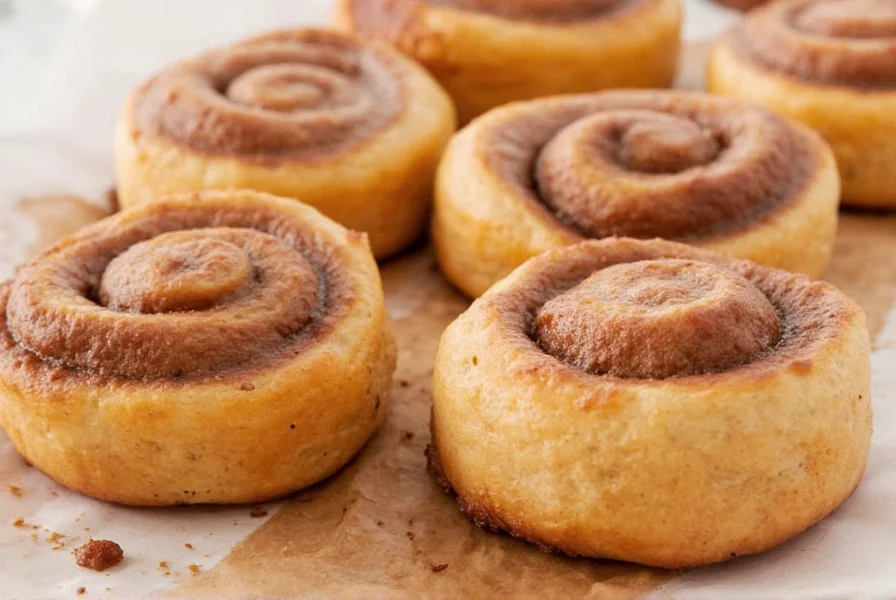Bakery cinnamon rolls achieve their signature soft texture, rich flavor, and perfect swirl through professional techniques and precise ingredient ratios that most home recipes miss. The key differences include professional yeast dough formulation, specific fat content, controlled fermentation, and specialized baking equipment that creates consistent steam distribution during baking.
Professional bakery cinnamon rolls stand apart from typical homemade versions through carefully calibrated techniques that most home bakers overlook. While many attempt to recreate that irresistible bakery quality, few understand the precise combination of ingredients, fermentation control, and baking methods that create those perfectly layered, melt-in-your-mouth pastries with consistent results batch after batch.
What separates truly exceptional bakery-style cinnamon rolls from ordinary homemade versions isn't just better ingredients—it's understanding the science behind dough development, proper fat incorporation, and controlled proofing that creates that distinctive tender crumb and signature swirl pattern. This guide reveals the professional techniques you can implement in your home kitchen to achieve results that rival your favorite bakery.
The Science Behind Bakery Cinnamon Roll Texture
Professional bakers rely on specific dough formulations that balance hydration, fat content, and fermentation time to create that distinctive bakery texture. The ideal bakery cinnamon roll dough contains 60-65% hydration (water relative to flour weight), which creates sufficient steam during baking to produce an open crumb structure while maintaining tenderness.
Unlike many home recipes that use quick-rise methods, professional bakeries employ a controlled cold fermentation process lasting 12-24 hours. This extended, temperature-regulated proofing develops complex flavors while allowing gluten to fully relax, resulting in rolls that pull apart effortlessly without becoming gummy. The slow fermentation also creates natural sugars that caramelize beautifully during baking.

Essential Ingredients for Authentic Bakery Flavor
While basic cinnamon roll recipes share similar ingredients, professional bakeries use specific formulations that create superior results:
| Ingredient | Home Recipe Typical Amount | Professional Bakery Standard | Why It Matters |
|---|---|---|---|
| Butter | 1/2 cup (1 stick) | 3/4-1 cup (1.5-2 sticks) | Higher fat content creates richer flavor and tender layers |
| Yeast | 2 1/4 tsp instant | 1-1.5% of flour weight | Precise measurement ensures consistent rise without yeast flavor |
| Sugar | 1/2-3/4 cup | 15-18% of flour weight | Optimal caramelization and browning during baking |
| Eggs | 1 large | 8-10% of flour weight | Contributes to structure and golden color |
The cinnamon filling in professional bakery rolls typically uses a 3:1 ratio of brown sugar to cinnamon, with the addition of a small amount of corn syrup or honey to prevent crystallization and create that signature sticky texture. Many commercial bakeries also incorporate a touch of espresso powder to deepen the cinnamon flavor without adding coffee taste.
Professional Techniques You Can Use at Home
Recreating bakery-quality cinnamon rolls at home requires adopting professional methods that most standard recipes omit. Here's how to implement these techniques:
Master the Dough Temperature
Professional bakers maintain dough temperature between 76-78°F (24-25°C) after mixing. This precise temperature control ensures consistent yeast activity. At home, use a digital thermometer and adjust water temperature (typically 90-100°F/32-38°C) based on your kitchen conditions to achieve the target dough temperature.
Implement the Windowpane Test Properly
Before shaping, professional bakers perform the windowpane test to verify gluten development. Stretch a small piece of dough between your fingers—if you can create a translucent "window" without tearing, the gluten is properly developed. Underdeveloped dough won't hold its shape, while overdeveloped dough becomes tough.
Rolling Technique for Perfect Swirls
The professional method for rolling cinnamon rolls involves:
- Rolling the dough rectangle to uniform 1/4-inch thickness
- Spreading filling from edge to edge without leaving borders
- Starting the roll from the long side with gentle but firm pressure
- Using a dental floss or unflavored thread to cut rolls (prevents squishing)
- Maintaining 1.5-inch spacing in the baking pan for even expansion
Common Mistakes That Prevent Bakery-Quality Results
Even experienced home bakers make these critical errors when attempting professional-style cinnamon rolls:
- Incorrect proofing conditions—Bakery ovens have humidity-controlled proofers; at home, create a warm (80-85°F/27-29°C), moist environment using an oven with just the light on and a pan of hot water below
- Overfilling with cinnamon mixture—Excess filling leaks out during baking, creating burnt spots and preventing proper rise
- Using melted butter in the dough—Professional recipes incorporate solid, cool butter to create distinct layers
- Opening the oven during baking—Professional ovens maintain consistent temperature; home ovens lose heat, causing rolls to collapse

Bakery vs. Homemade: What Really Matters
While commercial bakeries have advantages like deck ovens that provide consistent steam and professional mixers that develop gluten perfectly, home bakers can achieve remarkably close results by focusing on these critical elements:
The most significant factor in recreating bakery cinnamon rolls at home is controlling the fermentation process. Instead of the standard 1-2 hour rise, try a 12-18 hour cold fermentation in the refrigerator. This extended, temperature-controlled proofing develops complex flavors while allowing gluten to fully relax, resulting in rolls that pull apart effortlessly.
Another professional secret is the fat incorporation method. Rather than melting butter into the dough, professional bakers cut cool butter into small cubes and incorporate it gradually, creating distinct layers that separate during baking. This technique, similar to laminating croissant dough, produces that signature flaky, layered texture.
Perfecting Your Cinnamon Roll Icing
Professional bakery icing differs from typical powdered sugar glazes in both texture and flavor complexity. The key elements include:
- Fat content—Many professional recipes include a small amount of cream cheese or butter in the icing for richness
- Moisture balance—Using half milk and half cream creates the ideal consistency that's pourable but sets properly
- Flavor depth—A pinch of sea salt and pure vanilla extract elevate simple powdered sugar icing to professional quality
For the authentic bakery experience, apply icing while rolls are still warm (110-120°F/43-49°C)—this allows the glaze to melt slightly into the surface without running off completely.
What makes bakery cinnamon rolls softer than homemade versions?
Bakery cinnamon rolls achieve superior softness through precise hydration levels (60-65%), controlled cold fermentation (12-24 hours), and higher fat content (3/4-1 cup butter per batch). Professional bakeries also use dough conditioners like ascorbic acid that strengthen gluten structure while maintaining tenderness, and they bake in deck ovens that provide consistent steam during the critical first minutes of baking.
How can I make bakery-style cinnamon rolls without a stand mixer?
You can make professional-quality cinnamon rolls by hand using the "stretch and fold" technique. After initial mixing, perform 4-6 stretch and folds at 30-minute intervals during the first rise. This develops gluten structure without overworking the dough. Use cool (not cold) butter cut into small cubes, and incorporate it gradually while folding. The key is patience—allow proper fermentation time (12-18 hours cold proof) to compensate for less mechanical gluten development.
Why do my homemade cinnamon rolls collapse after baking?
Cinnamon rolls collapse primarily due to under-proofing or temperature shock. Professional bakeries proof rolls to 80-90% of final size (they should jiggle slightly when tapped). At home, ensure rolls have doubled in size and feel airy before baking. Avoid opening the oven during the first 15 minutes of baking, as temperature fluctuations cause collapse. Using an oven thermometer to verify accurate temperature (typically 350-375°F/175-190°C) also prevents this issue.
What's the secret to getting perfect swirls in bakery cinnamon rolls?
Professional bakers achieve perfect swirls through precise dough thickness (1/4 inch), even filling distribution, and proper rolling technique. Roll the dough tightly but gently from the long side, using the palm of your hands to apply even pressure. When cutting, use unflavored dental floss or thread pulled through the rolls rather than a knife to prevent squishing. Space rolls 1.5 inches apart in the pan to allow for even expansion without merging together.











 浙公网安备
33010002000092号
浙公网安备
33010002000092号 浙B2-20120091-4
浙B2-20120091-4